The Wine Cellar
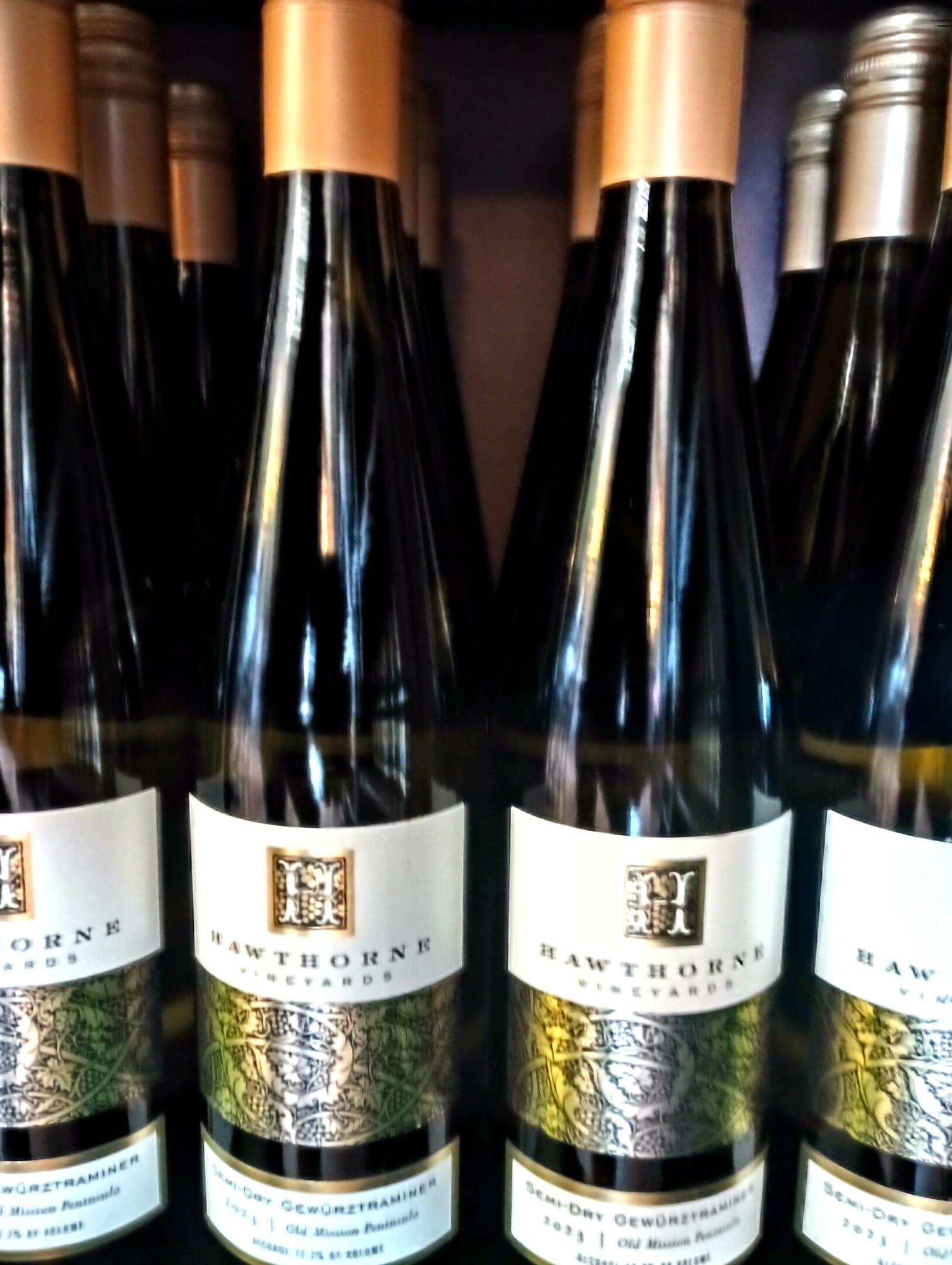
Gewürztraminer
Gewürztraminer- is an aromatic white wine grape variety, and which performs best in cooler climates. On our Award-Winning Wine Tours, guests often learn that "Gewürz" means "herb" or "spice" in German. In English and French, it is usually written Gewurztraminer (without the umlaut). Gewürztraminer is a variety with a pink to red skin color, which makes it a "white wine grape" as opposed to the blue to black-skinned varieties commonly referred to as "red wine grapes". Gewurztraminer grapes grow very well in the Traverse City area. The variety has high natural sugar and the wines are white and usually off-dry. Pictured is the Hawthorne Vineyards Gewurztraminer which is done semi-dry and is a Movie Stars Wine Tours staff favorite. Chateau Chantal, Bowers, Chateau Grand Traverse, Brys also have Gewurztraminer from dry to sweet.
Fruit- Lychee, stone fruit, tropical fruit, pineapple, peach, apricot, oranges, cantaloupes
Spice - ginger, lemongrass, allspice, cinnamon
Floral - rose
Other - Honey, incense, smoke, first time I heard the Beatles
Food pairing - duck, Indian food, curry dishes, crab, shrimp, kung pao chicken, szechuan style, candied ginger, munster, gorgonzola, gouda, stilton, roquefort cheeses
Staff pairing - Butcher Block Tortilla encrusted tilapia with Cholula hot sauce

Riesling
Riesling ( REE-sling, REEZ-ling) is a white grape variety that originated in the German Rhine region, which grows very well in the Traverse City wine region. Riesling is an aromatic grape variety displaying flowery, almost perfumed, aromas combined with high acidity. Guests on our award-winning wine tours learn that Riesling grapes are used to make dry, semi-sweet, sweet, and sparkling wines. Riesling wines are usually varietally pure and are seldom oaked. Some wine experts know that Riesling is one of the world's most popular grape varieties and is estimated to be in the world's top 20th most grown variety. Wine connoisseurs also know that in terms of importance for quality wines, it is usually included in the "top three" white wine varieties together with Chardonnay and Sauvignon blanc, all 3 of which grow exceptionally well in Traverse City. Riesling is a variety that is highly "terroir-expressive", meaning that the character of Riesling wines is greatly influenced by the wine's place of origin and that is good because the sandy soil, terrain and weather here in the Traverse City area is perfect for Riesling grapes. Pictured is the Chateau Chantal Proprietor's Reserve Riesling which is a dry Riesling which is a Movie Stars Wine Tours recommendation. All of the wineries on our Award Winning Traverse City Wine Tours have Riesling from dry to sweet.
Fruit - peaches, pears, apple, apricot, pineapple, nectarine, lemon
Aroma - floral aroma, jasmine, citrus blossom, ginger, honey, honeycomb, beeswax
Color - dry rieslings are lighter, sweet rieslings are darker golden or yellow
Acidity - Riesling are usually higher in acidity which produces a crisper or more tart tasting experience
Food pairing - dry rieslings usually pair well with seafoods, oysters, mussels, crabs, pastas. Rieslings pair with pork, the floral aromatics and sweetness of rieslings often pair well with fried chicken or spicy Indian, Thai or Mexican food. Gruyere goat cheeses pair very well.
Magic Mike's pairing - TC Taqueria Mexican Restaurant on 3 Mile Road in Traverse City.
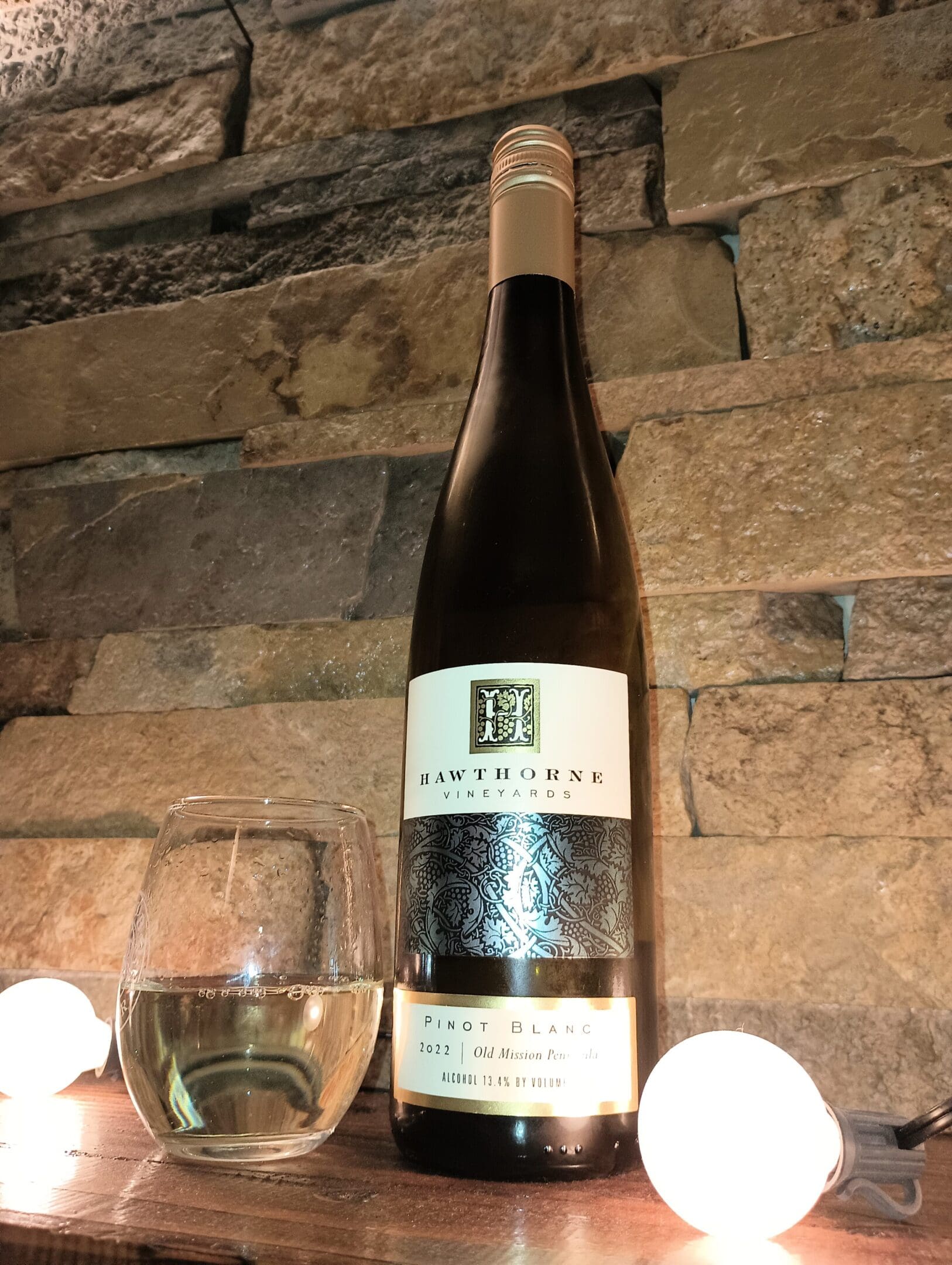
Pinot Blanc
Pinot Blanc is the white grape variation or "mutation" of Pinot Noir. Found mostly in Germany and Northern Italy, this grape grows great here in the Traverse City area. Pinot Blanc is grown in many different wine regions, Pinot blanc is known for its fruity aromas, often of apple, citrus fruit, and floral characteristics. Pinot Blanc is one of the most popular wines on our tours and oftentimes is a strong staff favorite. Pictured is the Hawthorne Vineyards Pinot Blanc. Guests on our Award-Winning Traverse City Wine Tours will be able to sample various Pinot Blanc at the winery stops.
Fruit - peaches, nectarines, apricots, baked pear, papaya, lemon
Floral - elderflower, apple blossom, white flowers
Nuts - almonds
Earthy - stony minerality
Smoky - slight smokiness
Food pairing-seafood, cod, swordfish, sea bass, pasta, chicken
Kyle's pairing - brisket

Pinot Grigio / Pinot Gris
Pinot Grigio or Pinot Gris is a white wine varietal grown in many of the vineyards here in Traverse City. Pinot Grigio or Pinot Gris grapes are a deep golden yellow to copper colors and sometimes produce a very light shade of pink. Pinot Grigio or Pinot Gris grapes are harvested earlier to retain the acidity and to not create a wine that is overbearing in its fruitiness. Pinot Grigio's origins are known to date back to the Middle Ages in the Burgundy, France region. What is the difference between Pinot Grigio and Pinot Gris? The big difference between Pinot Gris and Pinot Grigio wine is how it's produced. Pinot Gris is usually made from the ripest grapes and aged in wood barrels. Pinot Grigio is usually harvested earlier in the season, creating a crisper and drier flavor. Pinot Grigio is usually aged in stainless steel, which adds to the fresh taste. Pictured is the Hawthorne Vineyards Pinot Grigio however this grape is offered by most of the wineries on our Award Winning Traverse City Wine Tours.
Fruits - Lemon, lime, orange, green apple, pear, peaches, honeydew melon
Floral - subtle floral aromas, white floral notes, citrus blossom
Spice-light spices, almond, honey, ginger
Earthy - hints of minerality
Food Pairing-shellfish, sushi, oysters, chicken, avocado, goat cheese, grilled veggies
Jill's Pairing - scallops

Sauvignon Blanc
Sauvignon Blanc grapes historically have been grown in the Loire Valley (France), California, Chile, New Zealand, Australia, Italy, South Africa, and now Traverse City. This grape ripens early, so it is best to be grown in regions with a lot of sun but not extreme heat temperatures as it can cause the Sauvignon Blanc grape to over-ripen and produce dull and acidic wines. Guests on our Award Winning Traverse City Wine Tours can get a glass or bottle of the Sauvignon Blanc from Brys Estates or pictured is the Bonobo Fume Blanc which is an estate-grown uniquely blended wooded Sauvignon Blanc.
This complex wine has aromas of pear, notes of lemon citrus, subtle hints of fresh coconut flavors and a white floral component.
Food pairing - Enjoy this food-friendly wine with fresh seafood like ceviche, charcuterie, or with Asian food and vegetables.
Troy's pairing The Idaho Pizza from That'sa Pizza

Chardonnay
Chardonnay is an extremely popular green-skinned grape variety used in the production of white wine. The variety originated in the Burgundy wine region of eastern France but is now grown wherever wine is produced, from England to New Zealand to the vineyards here in Traverse City. Guests on our tours will see both wooded and unwooded Chardonnay wines in the local wineries. Unoaked Chardonnay also referred to as unwooded or naked is aged in metal or stainless steel making a light to medium body crisp bright white wine often with notes of apple, citrus, or other crisp fruits. Wooded or oaked Chardonnay is aged in wood usually creating a richer medium-bodied "buttery" white wine often with a creamy mouthfeel and notes of butter, cream, roasted nuts, vanilla, caramel, and baking spices. Oaked Chardonnay often has a darker golden color. Pictured is the Flagship Wine Barrel Reserve Chardonnay from Hawthorne Vineyards.
Chardonnays from cooler climates, like Chablis in Burgundy or parts of California, tend to be crisp and mineral-driven with notes of green apple, lemon zest, and citrus. Chardonnays from warmer climates, like Australia, California's Central Coast, or parts of South America, tend to be richer and creamier with notes of tropical fruit like pineapple, papaya, mango, and guava
Food pairing - white fish, shellfish, lobster, fish in creamy/butter sauces, pasta, brie and monterey jack cheese
Tracy's pairing Salmon
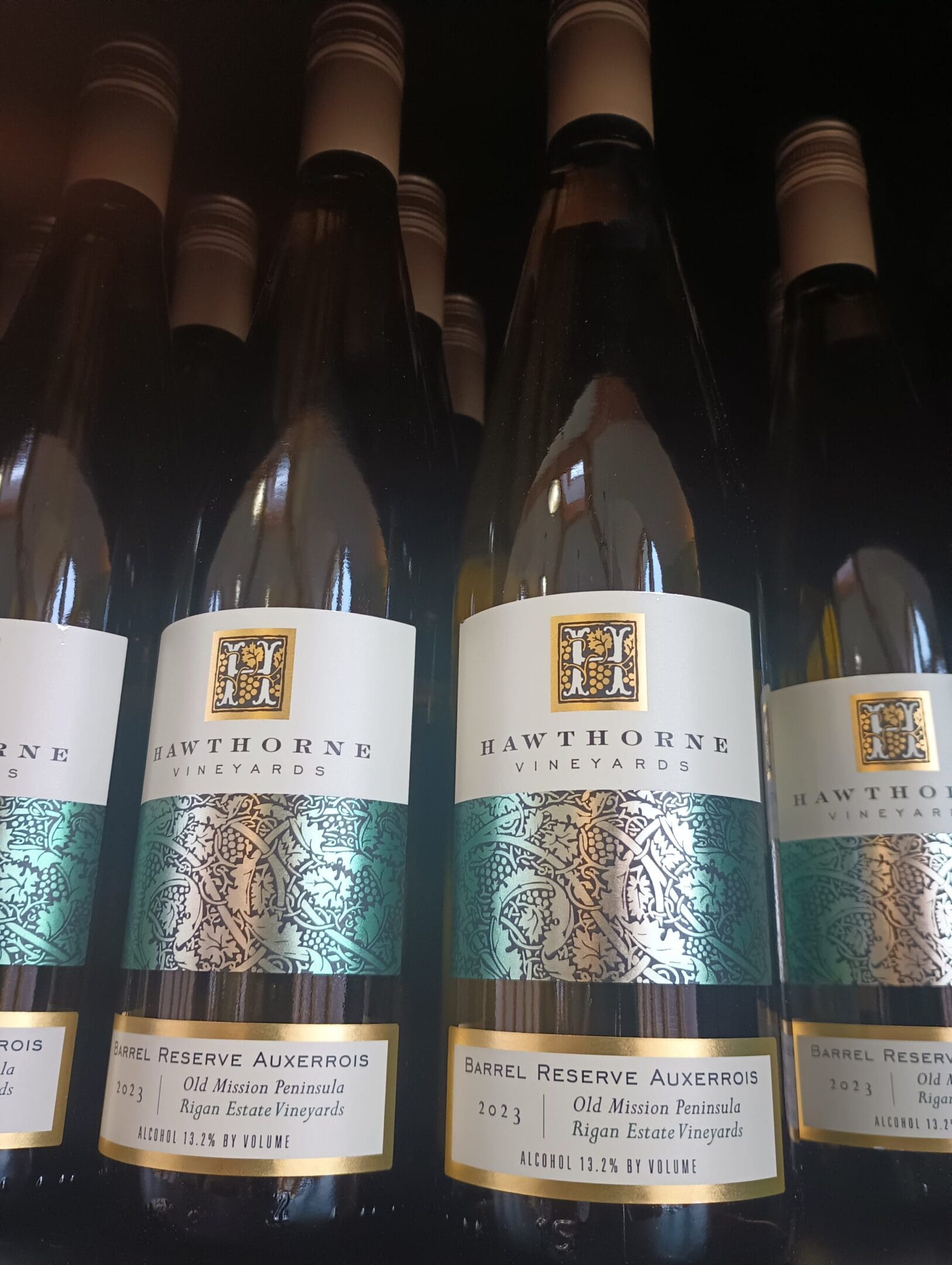
Auxerrois
Auxerrois (awk-ser-WAH) may not be one of Frances' or Traverse City's best-known grapes, but it's undeniably important. Some refer to it as Pinot Auxerrois in the region, sometimes mistaken for Pinot Blanc or a wooded Chardonnay. Some wine experts claim that Auxerrois is a sibling of Chardonnay. Both are hybrids of Pinot Noir and Gouais Blanc and in the Moselle region of France, Chardonnay is often called Auxerrois Blanc. Auxerrois most likely takes its name from Auxois, a town in Burgundy, however, taken to the next level in Northern Michigan's wine country here in Traverse City. Pictured is the Barrel Reserve Auxerrois from Hawthorne Vineyards, Chateau Chantal also makes a very good Auxerrois which our guests can compare and contrast.
Fruits - citrus mandarin and lemon, pear, baked apple
Tea - white tea, shortbread cookies, limoncello
Savory tones - pie crust, biscotti, bitter-citrus oil, honey
Aroma - rich musky aroma
Food pairing - seafood, white meats, poultry, omelets, quiches, soft cheeses, spicy dishes
Magic Mike's Jr's suggested future pairing - Costco chili and Hebrew National hot dogs
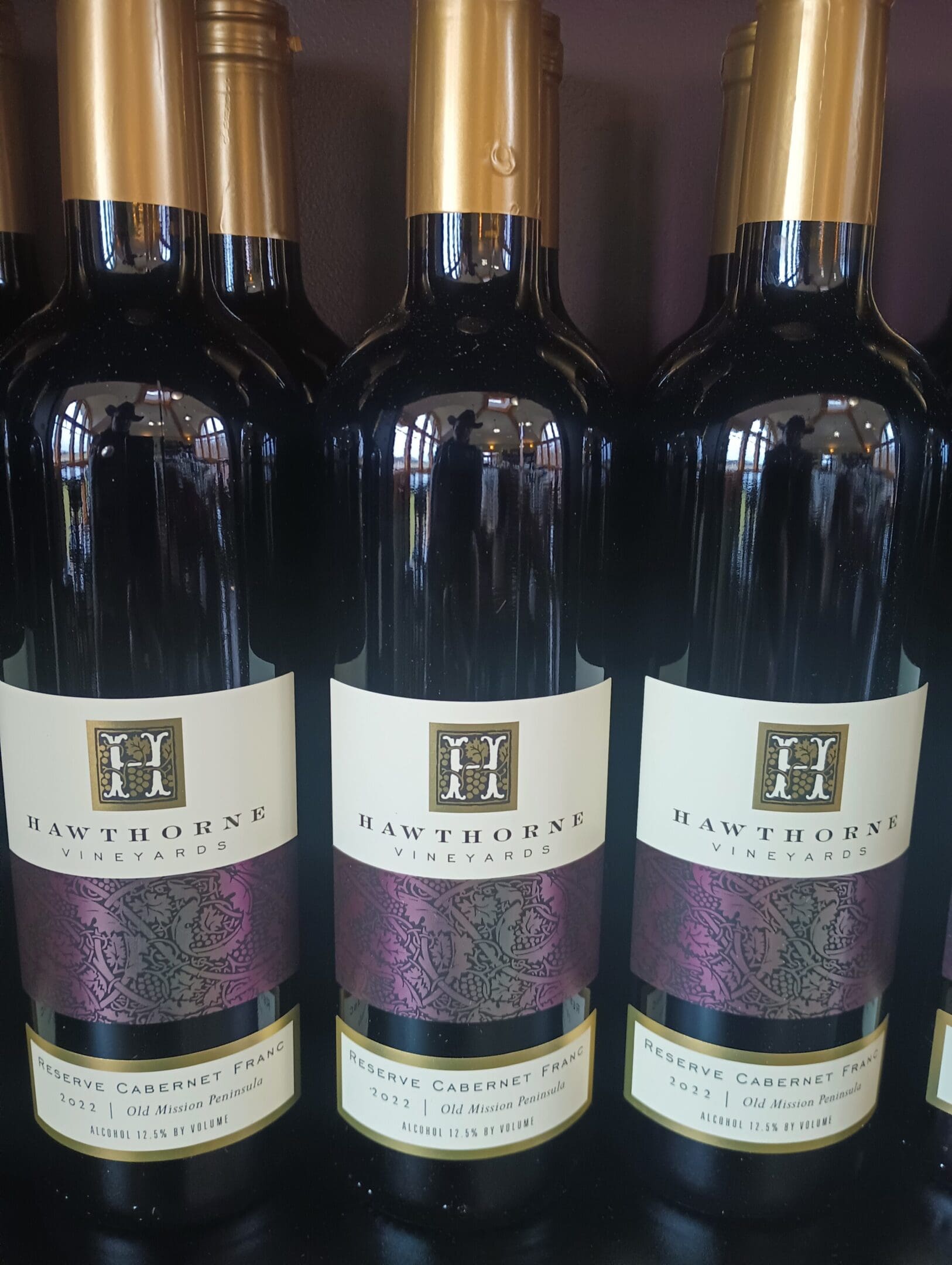
Cabernet Franc
Cab Franc is a parent grape of Merlot, Cabernet Sauvignon, and Carménère giving a hint of mint or green bell pepper. Depending on where Cab Franc is grown, these grapes can be lighter or bolder, however always tasty. Cab Franc is one of the major black grape varieties worldwide. It is principally grown for blending with Cabernet Sauvignon and Merlot in the Bordeaux style, but can also be vinified alone, as in the Traverse City area. Pictured is the Hawthorne Vineyards Reserve Cabernet Franc. 2022, 2023, and 2024 were excellent years for the local Traverse City Cab Franc grapes so fans of this variety are in luck! Book one of our award-winning Traverse City Wine Tours to sample Cabernet Franc wines from various wineries.
Fruit - cherries, strawberries, raspberries, blackberries, black currant
Herbs - mint, chamomile, cigar, tobacco
Earthy - green peppercorn, green bell pepper, minerality
Other - tobacco, leather, violets, baking spices
Food pairing - ribeye steak, lamb chops, pork ribs, burgers, sausage, brats, pate, parmesan, brie and blue cheeses.
Jason's food pairing - The Mushroom burger from Bubba's Burgers in downtown Traverse City

Pinot Noir
Pinot Noir is also sometimes known as Pinot nero, a red-wine grape variety of the species Vitis vinifera. The name also refers to wines created predominantly from Pinot noir grapes. The name is derived from the French words for pine and black. The word pine refers to the grape variety having tightly clustered fruit resembling a pinecone. Pinot noir is grown worldwide, mostly in cooler climates, and the variety is chiefly associated with the Burgundy region of France, however, it has become very popular here in the Traverse City wine region. Pinot noir is now used to make red wines around the world, as well as champagne, sparkling white wines such as the Italian Franciacorta, and English sparkling wines. Pictured is the Bonobo Pinot Noir. Guests on our Traverse City Wine Tours will be able to compare 2 Pinot Noirs at Bonobo, Book Today!
Fruits- Strawberries, cherries, raspberries, cranberries, plum
Floral - subtle perfume, first love
Earthy - forest floor, mushrooms, truffles
Tea - hints of tea
Spices - vanilla, baking spices usually when aged in French oak
food pairing - Poultry, Beef, Fish, Ham, Lamb, Pork, Creamy sauces, Spicy seasonings, Soft cheeses, and Mushrooms
Andie's food pairing - Gordon's Pretzel Bites (bread isle- NOT frozen)
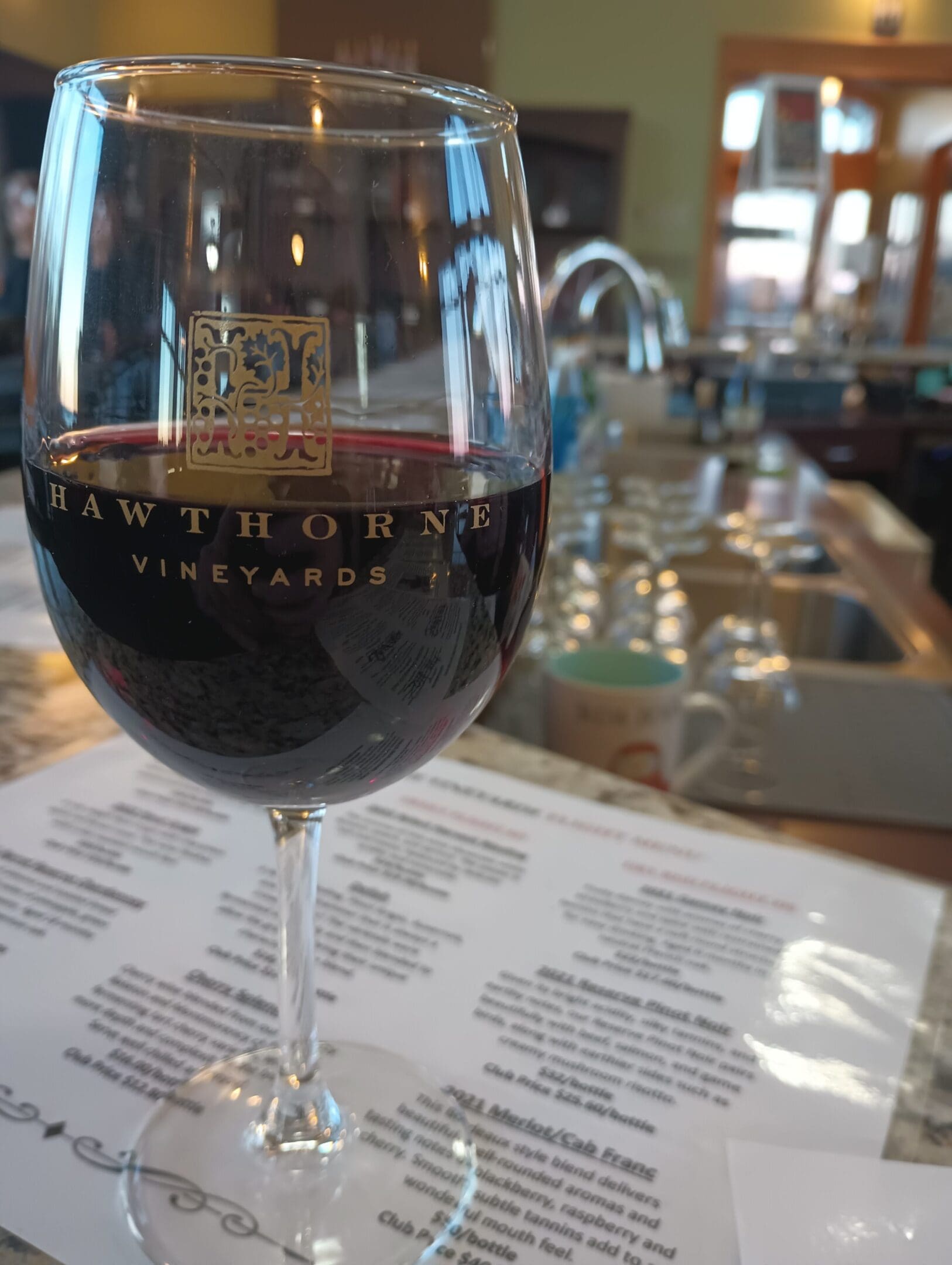
Gamay
Gamay is a purple-colored grape variety used to make red wines, most notably grown in Beaujolais and the Loire Valley France. Its full name is Gamay Noir à Jus Blanc. It is a very old cultivar, mentioned as long ago as the 15th century. It has been often cultivated because it makes for abundant production; however, it can produce wines of distinction when planted on acidic soils, which help to soften the grape's naturally high acidity. Gamay grows great here in the Traverse City wine region and is very popular with the guides here at Movie Stars Wine Tours. Pictured is the Hawthorne Vineyards Gamay Noir. Chateau Grand Traverse also has a selection of Gamay wines available for guests to sip and savor.
Fruit- raspberries, red cherries, blackberries, wild strawberries
Tartness - red plum, raspberries, red cherries
Floral - violet, peony
Earthy - subtle earthy undertones
Banana and bubble gum - some varieties have flavors of strawberry, banana, bubble gum, first kiss
Food pairing - roast chicken, aged cheeses, mushrooms, braised duck, roast butternut squash, falafel, caramelized onions
Tony's pick - oven-baked mac & cheese

Merlot
Merlot is a dark blue-colored wine grape variety that is used as both a blending grape and for varietal wines. The name Merlot is thought to be derived from the word merle, the French name for the blackbird, probably a reference to the color of the grape. Its softness and "fleshiness," combined with its earlier ripening, make Merlot a popular grape for blending with the sterner, later-ripening Cabernet Sauvignon, which tends to be higher in tannin. Pictured is a Chateau Grand Traverse Merlot. Guests can enjoy a glass or red on our Award-Winning Traverse City Wine Tours overlooking the many vineyards on the list of stops.
Fruit - plum, black cherries, raspberries
Spice - vanilla, cloves, love, other sweet spices
Earthy - graphite and dried earth
Floral - purple floral top notes
Chocolate - dark chocolate notes
Food pairing - bbq chicken, pasta, roast turkey, beef, ribs, lamb, veal, filet mignon, gouda, brie, chocolate
Kyle's pick - pepperoni pizza from Thatsa' Pizza

Lemberger
Lemberger which is also known as Blaufränkisch is a dark-skinned variety of grape used for red wine and has become very popular here in the Traverse City wine region. Lemberger is usually produced in smaller lots and is a late-ripening variety, produces red wines which are typically rich in tannin and may exhibit a pronounced spicy black pepper character. Outstanding wine produced by some of the wineries here in Northern Michigan definitely put some in the cellar.
Lemberger wines can be fruity or tannic and can have a long-lasting aftertaste. The wine's flavor profile can depend on the production method and the grape's aging. Some Lemberger wines are aged in barrels, which in some cases can give the wine a southern charm and warmth. Pictured is the Hawthorne Vineyards Lemberger which is STELLAR!
Fruit-blackberries, red cherries, plums, raspberries, currants, gooseberries, bananas
Spice - black pepper, cinnamon, cracked black peppercorn, heaven
Vegetative - green beans, peppers
Oak - smokey oak
Chocolate - chocolate
Food pairing - Pork, smoked meats, steak, hearty cheese, red peppers, seafood, brats, lamb.
Magic Mike's food pairing - Tyson's Chicken Nuggets-for the kids, steak for the Mrs

Champagne
Well, we can't call it Champagne because we aren't in Champagne. Here in Traverse City, there is a lot of "Champagne Methode" or method or "bubbly", and we don't want any trouble with the French. Guests on our award-winning wine tours will see Blanc de Blancs, Cuvees, Champagne Methode Rose, and Pinot Secco. If you are a bubbly fan, our tours are for you! Pictured below is the super popular Bonobo Bubbly Rose'.

Muscat
Muscat is one our favorites. Because the exact origins of the Muscat family cannot be pinpointed, theories as to the origin of the name "Muscat" are numerous. The most commonly cited is that it is derived from the Persian word muchk. Similar etymology follows the Greek moskos, Latin muscus and French musc. In Italy, the Italian word mosca for fly could also be one possibility with the sweet aroma and high sugar levels of Muscat grapes attracting insects such as fruit flies.
Other theories suggest that the grape family originated in the West Asian country of Oman and was named after the city of Muscat located on the coast of the Gulf of Oman. Another city that is sometimes suggested as a potential birthplace/namesake is the Greek city of Moschato, located southwest of Athens in Attica, with Moschato being a common synonym in Greece for Muscat varieties.
Legend has it that Muscat grapes were the first grapes the conquering Romans brought to Europe. Pictured below is a Semi-dry Muscat from Shady Lane on Leelanau Peninsula which is one of Magic Mike's strong recommendations.

ROSE'
Some guests book our tours and at the beginning of the tour say they aren't sure about Rose' wines. As the juice from grapes is actually clear, how is rose' wine made? The color of the wine actually comes from the skin of the grapes, not the juice itself. But, as pink grapes don’t exist, some guests ask where does rose' get it's color from?
Rosé wine is actually made using the same process as red wine as red grapes are used to create it. However, as the color comes from the skin, the macerating process where the skin is left to soak is shortened so that the wine can become its signature pink color.
The process of making rosé wine involves crushing red grapes and allowing the juice to soak with the skins but not for as long as they do with red wine. There are many different rose' style wines on our Award-Winning Traverse City Wine Tours. Pictured is the Bonobo Rose' which is just amazing.

Cider
Cider has become a big business here in Northern Michigan and guests on our Award-Winning Traverse City Wine Tours will be able to sample many different types of ciders. We are seeing a transition from cherries to other types of fruit such as grapes, apples, etc. Many foreign countries have dumped their cherries on the American market which has made it increasingly difficult for farmers to make money on cherries. So as local cherry orchards outgrow their producing life, some orchards are replaced with new vineyards or apple orchards. Pictured are some of the ciders available at Bowers Harbor Vineyards. Cider fans are in luck! Book one of our Award-Winning Traverse City Wine Tours today!
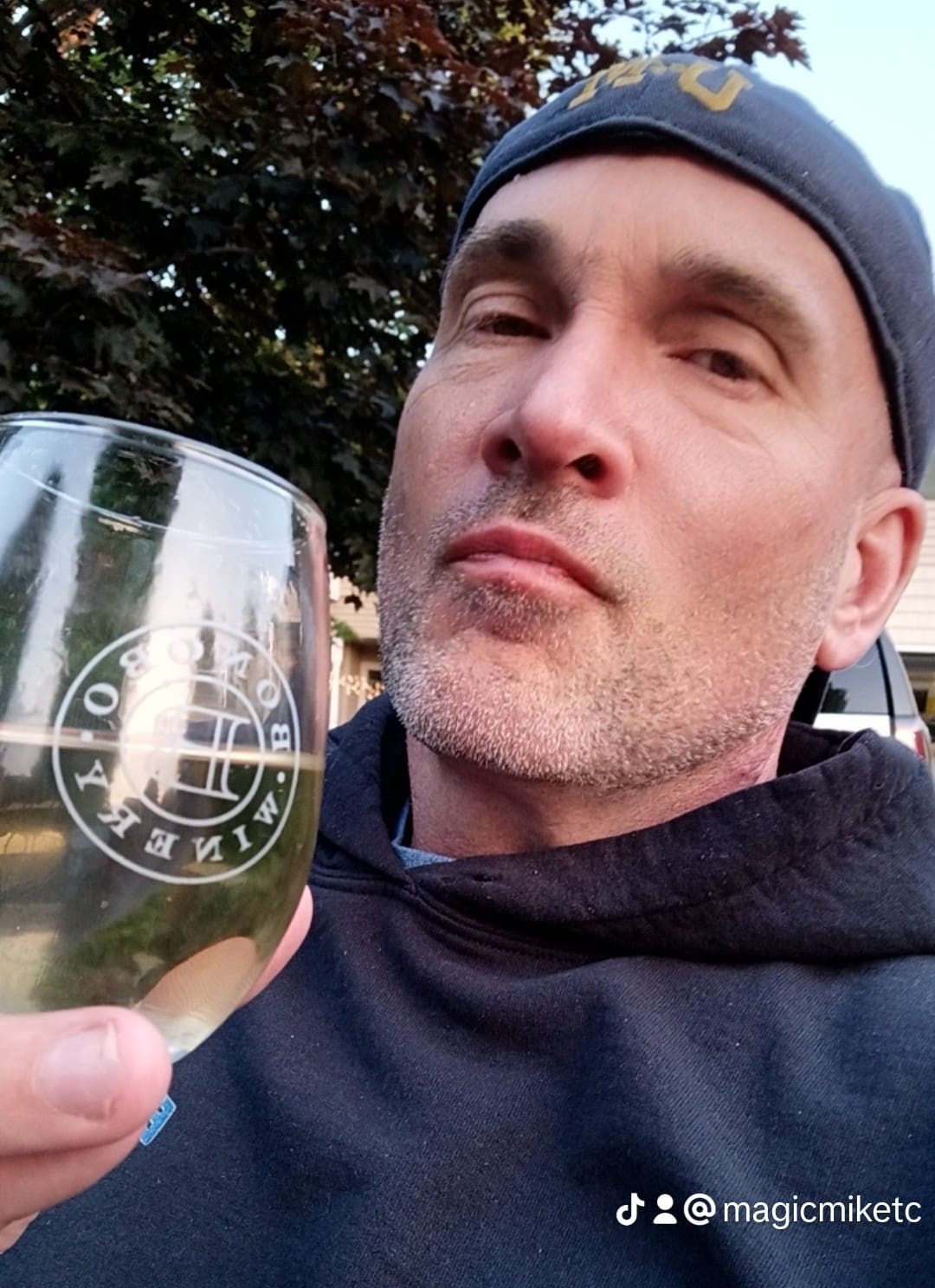
Questions?
Any questions about the local wines, ciders or other drinks let us know at moviestarstc@gmail.com or text at (231) 360-1267.
